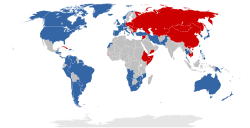Second World

The Second World is the former industrial socialist states (formally the Eastern Bloc) largely encompassing territories under the influence of the Soviet Union. Following World War II, there were 19 communist states, and after the fall of the Soviet Union, only five socialist states remained: China, North Korea, Cuba, Laos, and Vietnam. Along with "First World" and "Third World", the term was used to divide the states of Earth into three broad categories.
The concept of "Second World" was a construct of the Cold War and the term is still largely used to describe former communist countries that are between poverty and prosperity, many of which are now capitalist states. Subsequently the actual meaning of the terms "First World", "Second World" and "Third World" changed from being based on political ideology to an economic definition.[1] The three-world theory has been criticized as crude and relatively outdated for its nominal ordering (1; 2; 3) and sociologists have instead used the words "developed", "developing", and "underdeveloped" as replacement terms for global stratification (which in turn have been criticized as displaying a colonialist mindset) [2] —nevertheless, the three-world theory is still popular in contemporary literature and media. This might also cause semantic variation of the term between describing a region's political entities and its people.[3]
See also
References
- ^ Margaret L. Andersen; Howard Francis Taylor (2006). Sociology: Understanding a Diverse Society. Thomson/Wadsworth. p. 250. ISBN 978-0-534-61716-5.
- ^ Silver, Marc. "If You Shouldn't Call It The Third World, What Should You Call It?" NPR, 4 January 2015.
- ^ Giddens, Anthony (2006). Sociology. Polity. ISBN 9780745633794.
